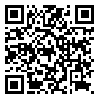1. Li Y, Bressington D, Chien WT. Systematic review of psychosocial interventions for people with spinal cord injury during inpatient rehabilitation: implications for evidence-based practice: psychosocial interventions for spinal cord injury. Worldviews Evid Based Nurs. 2017;14(6):499–506. [
DOI]
2. Rahmani Rasa A, Hosseini SA, Haghgoo H, Khankeh HR, Khankeh HR, Ray GG. Aspects related to resilience in people with spinal cord injury. J Rehabil. 2016;17(4):350–9. [Persian] [
DOI]
3. Besharat MA. Evaluating the effectiveness of paradox therapy for the treatment of obsessive-compulsive disorder: a case study. Journal of Psychological Studies. 2019;14(4):7–36. [Persian] [
Article]
4. Loevinger J, Blasi A. Ego development. San Francisco, CA: Jossey-Bass Publishers; 1976.
5. Cramer P. Psychological maturity and change in adult defense mechanisms. J Res Pers. 2012;46(3):306–16. [
DOI]
6. McCrae R, Costa P. Personality in adulthood. Second edition. New York, NY: Guilford Press; 2006.
7. Besharat MA, Zahedi Tajrishi K, Noorbala AA. Alexithymia and emotion regulation strategies in patients with somatization, anxiety disorders, and normal individuals: a comparative study. Contemporary Psychology. 2014;8(2):3–16. [Persian]. [
Article]
8. Ghorbani N, Watson PJ, Hargis MB. Integrative Self-Knowledge Scale: correlations and incremental validity of a cross-cultural measure developed in Iran and the United States. J Psychol. 2008;142(4):395–412. [
DOI]
9. Calandri E, Graziano F, Borghi M, Bonino S. Coping strategies and adjustment to multiple sclerosis among recently diagnosed patients: the mediating role of sense of coherence. Clin Rehabil. 2017;31(10):1386–95. [
DOI]
10. Lim SW, Shiue YL, Ho CH, Yu SC, Kao PH, Wang JJ, et al. Anxiety and depression in patients with traumatic spinal cord injury: a nationwide population-based cohort study. Plos One. 2017;12(1):e0169623. [
DOI]
11. Zürcher C, Tough H, Fekete C, for the SwiSCI Study Group. Mental health in individuals with spinal cord injury: the role of socioeconomic conditions and social relationships. Plos One. 2019;14(2):e0206069. [
DOI]
12. Sadock BJ, Ruiz P, Sadock VA. Kaplan and Sadock's synopsis of psychiatry: behavioral sciences/clinical psychiatry. Philadelphia: Wolters Kluwer; 2015.
13. Halgin RP, Krauss S. Abnormal psychology: clinical perspectives on psychological disorders. Second edition. Dubuque, IA: William C Brown Pub; 1998.
14. Besharat MA. Development and validation of Ego Strength Scale: a preliminary study. Psychological Science. 2017;15(60):445–67. [Persian] [
Article]
15. Lovibond SH, Lovibond PF. Manual for the depression anxiety stress scales. Second edition. Sydney Australia: School of Psychology, University of New South Wales; 1995.
16. Besharat MA. Examining the psychometric properties of the Depression Anxiety Stress Scale (DASS-21) in clinical samples and the general population. Research Report, University of Tehran; 2004.
17. Besharat MA. Mental Scale of Treatment Outcomes (TOSRS). Research report, University of Tehran; 2003. [Persian].
18. Craske MG, Barlow DH. Mastery of your anxiety and panic: therapist guide. 4th edition. Oxford; New York: Oxford University Press; 2007.
19. Craske MG, Kircanski K, Zelikowsky M, Mystkowski J, Chowdhury N, Baker A. Optimizing inhibitory learning during exposure therapy. Behav Res Ther. 2008;46(1):5–27. [
DOI]
20. Eifert GH, Forsyth JP. Acceptance and commitment therapy for anxiety disorders: A practitioner's treatment guide to using mindfulness, acceptance, and values-based behavior change strategies. Oakland, CA: New Harbinger Publications; 2005.
21. Zahrakar K, Hasanzade A, Zare M. The efficacy of group counseling by the method of logo therapy in reducing hopelessness among the spinal cord injured handicaps, after the Zarand earthquake. Journal of Psychological Studies. 2012;8(1):67–94. [Persian] [
Article]
22. Torabian S, Aslani Slams J, Amini D. Barrasi tasire darmane mobtani bar paziresh va ta’ahod bar rahbord haye moghabele’i dar bimaran ba zaye’aate nokhaei [The effect of acceptance and commitment-based therapy on coping strategies of patients with spinal cord injuries]. In: Third International Conference on Management, Accounting, Economics and Humanities [Internet]. 2016. [Persian]
23. Baran Oladi S, Sheykhpoor N, Mortazavi SM, Sabahi A. The Effect of Group Logotherapy on hopeness in spinal cord injury patients. Knowledge and Research in Applied Psychology. 2018;19(2):97–105. [Persian] [
Article]
24. Ebrahimi Z. Asar bakhshiye gorouh darmani shenakhti - raftari bar afsordegi mardan mobtala be zaye’eye nokhaei [The effectiveness of cognitive-behavioral group therapy on depression in men with spinal cord injuries]. Quarterly Journal of New Ideas in Psychology. 2019;5(9):1–11. [Persian] [
Article]





